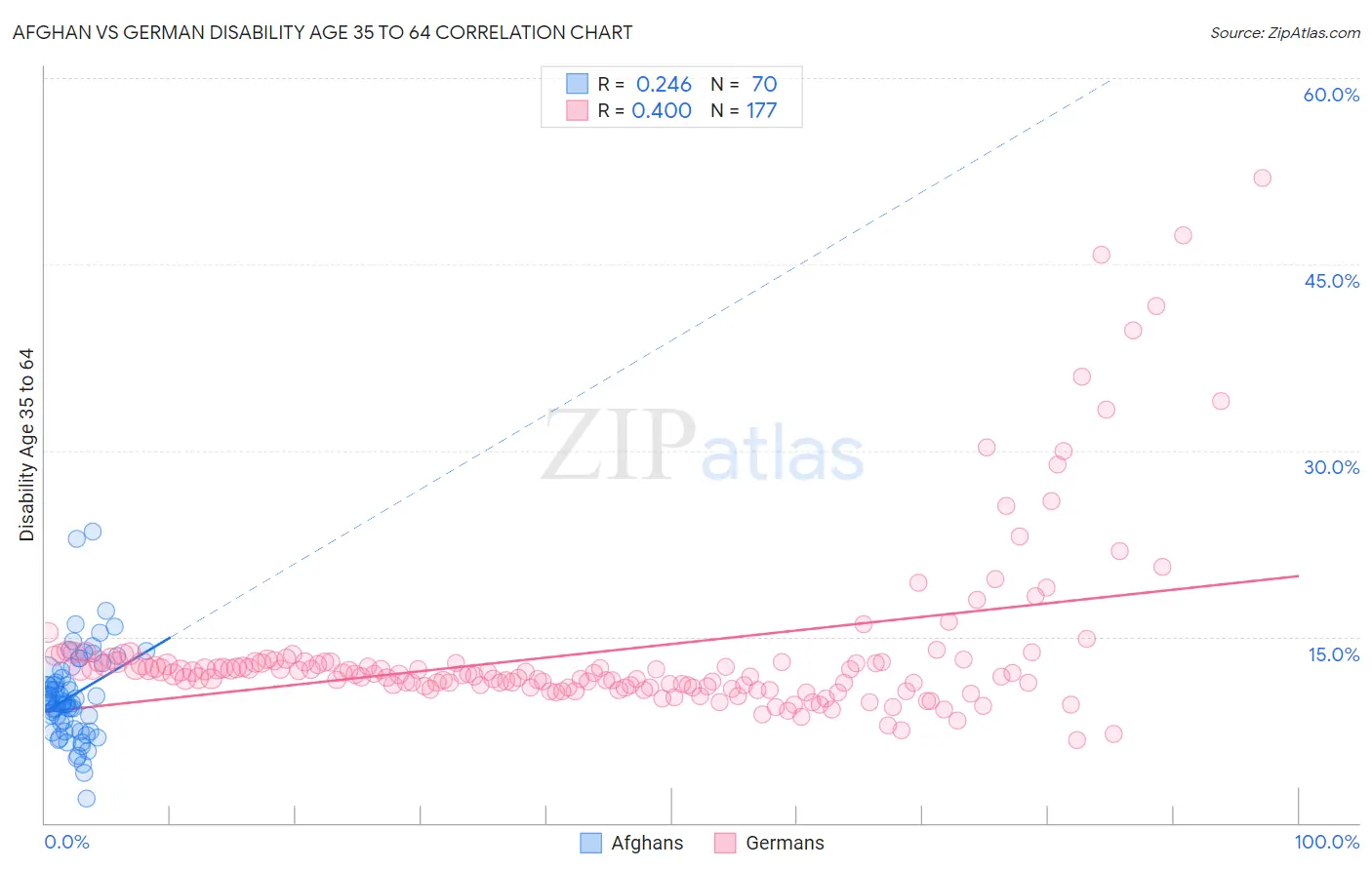Afghan vs German Disability Age 35 to 64
COMPARE
Afghan
German
Disability Age 35 to 64
Disability Age 35 to 64 Comparison
Afghans
Germans
10.3%
DISABILITY AGE 35 TO 64
98.9/ 100
METRIC RATING
90th/ 347
METRIC RANK
12.3%
DISABILITY AGE 35 TO 64
1.1/ 100
METRIC RATING
251st/ 347
METRIC RANK
Afghan vs German Disability Age 35 to 64 Correlation Chart
The statistical analysis conducted on geographies consisting of 148,816,709 people shows a weak positive correlation between the proportion of Afghans and percentage of population with a disability between the ages 34 and 64 in the United States with a correlation coefficient (R) of 0.246 and weighted average of 10.3%. Similarly, the statistical analysis conducted on geographies consisting of 579,726,444 people shows a mild positive correlation between the proportion of Germans and percentage of population with a disability between the ages 34 and 64 in the United States with a correlation coefficient (R) of 0.400 and weighted average of 12.3%, a difference of 19.8%.

Disability Age 35 to 64 Correlation Summary
| Measurement | Afghan | German |
| Minimum | 2.0% | 6.7% |
| Maximum | 23.5% | 52.0% |
| Range | 21.5% | 45.3% |
| Mean | 10.3% | 13.8% |
| Median | 9.7% | 12.0% |
| Interquartile 25% (IQ1) | 7.5% | 10.9% |
| Interquartile 75% (IQ3) | 12.2% | 13.0% |
| Interquartile Range (IQR) | 4.7% | 2.0% |
| Standard Deviation (Sample) | 3.8% | 7.1% |
| Standard Deviation (Population) | 3.7% | 7.1% |
Similar Demographics by Disability Age 35 to 64
Demographics Similar to Afghans by Disability Age 35 to 64
In terms of disability age 35 to 64, the demographic groups most similar to Afghans are Immigrants from Lebanon (10.3%, a difference of 0.010%), Uruguayan (10.2%, a difference of 0.11%), Chilean (10.2%, a difference of 0.12%), Immigrants from Northern Africa (10.3%, a difference of 0.33%), and Immigrants from Europe (10.2%, a difference of 0.36%).
| Demographics | Rating | Rank | Disability Age 35 to 64 |
| Immigrants | Brazil | 99.2 /100 | #83 | Exceptional 10.2% |
| Sri Lankans | 99.2 /100 | #84 | Exceptional 10.2% |
| Immigrants | Kuwait | 99.1 /100 | #85 | Exceptional 10.2% |
| Immigrants | Europe | 99.1 /100 | #86 | Exceptional 10.2% |
| Nicaraguans | 99.1 /100 | #87 | Exceptional 10.2% |
| Chileans | 99.0 /100 | #88 | Exceptional 10.2% |
| Uruguayans | 99.0 /100 | #89 | Exceptional 10.2% |
| Afghans | 98.9 /100 | #90 | Exceptional 10.3% |
| Immigrants | Lebanon | 98.9 /100 | #91 | Exceptional 10.3% |
| Immigrants | Northern Africa | 98.7 /100 | #92 | Exceptional 10.3% |
| Immigrants | North Macedonia | 98.7 /100 | #93 | Exceptional 10.3% |
| Immigrants | Italy | 98.7 /100 | #94 | Exceptional 10.3% |
| Chinese | 98.7 /100 | #95 | Exceptional 10.3% |
| Immigrants | South Africa | 98.5 /100 | #96 | Exceptional 10.3% |
| Immigrants | Denmark | 98.4 /100 | #97 | Exceptional 10.3% |
Demographics Similar to Germans by Disability Age 35 to 64
In terms of disability age 35 to 64, the demographic groups most similar to Germans are Immigrants from Burma/Myanmar (12.3%, a difference of 0.080%), Hispanic or Latino (12.3%, a difference of 0.21%), Spaniard (12.3%, a difference of 0.24%), Irish (12.3%, a difference of 0.25%), and Dutch (12.3%, a difference of 0.29%).
| Demographics | Rating | Rank | Disability Age 35 to 64 |
| Finns | 2.3 /100 | #244 | Tragic 12.1% |
| Immigrants | Mexico | 2.2 /100 | #245 | Tragic 12.1% |
| Guamanians/Chamorros | 1.4 /100 | #246 | Tragic 12.2% |
| Immigrants | Senegal | 1.3 /100 | #247 | Tragic 12.2% |
| Spaniards | 1.3 /100 | #248 | Tragic 12.3% |
| Hispanics or Latinos | 1.3 /100 | #249 | Tragic 12.3% |
| Immigrants | Burma/Myanmar | 1.2 /100 | #250 | Tragic 12.3% |
| Germans | 1.1 /100 | #251 | Tragic 12.3% |
| Irish | 1.0 /100 | #252 | Tragic 12.3% |
| Dutch | 1.0 /100 | #253 | Tragic 12.3% |
| Hawaiians | 0.9 /100 | #254 | Tragic 12.3% |
| Japanese | 0.8 /100 | #255 | Tragic 12.3% |
| Scottish | 0.8 /100 | #256 | Tragic 12.4% |
| Mexicans | 0.7 /100 | #257 | Tragic 12.4% |
| Welsh | 0.6 /100 | #258 | Tragic 12.4% |